Final report for FNC23-1384
Project Information
Curtis and Sarah Millsap started Millsap Farms 17 years ago. They started with a 1/4 acre market garden, pastured poultry, and some nursery production. They now run a 25 acre farm, with 2.5 acres of production, 1/3 of which is under cover. They produce cut flowers, vegetables, and fruit, for a 225 member, 9-month CSA program, as well as a year-round farmers market, and some wholesale sales. They use organic practices, avoiding synthetic fertilizers, pesticides, and herbicides, and have transitioned over the years from a heavy tillage model to minimum tillage/regenerative agriculture model. They are deeply involved with their community, hosting weekly wood-fired pizza nights from May to October for 250 people a week, and monthly "twilight walks". Both of these community events include farm tours with farmer Curtis, to see the fields and tunnels, explain regenerative agriculture, and encourage others to go further in their own growing endeavors. They love to tell the story of sustainable agriculture, and are passionate advocates of appropriate technology for small scale farming, such as efficient pack sheds, effective use of high tunnels, monitoring systems, irrigation, etc.
Jason Hirtz took part in his first SARE funded project at Ivan Stoilov’s Fig Farm in Dittmer, Missouri in 2007. Box Turtle Farm established in 2008 as a CSA. In 2011, his family relocated to a 16-acre farm in Mount Vernon, Missouri. Box Turtle Farm began marketing to grocery stores and restaurants, eventually expanding to over 16,000 square feet of high tunnels. In 2013, the farm obtained USDA organic certification. Since 2012, Box Turtle Farm has produced salad through winter. their first efforts were in temporary caterpillar tunnels. In 2016, they expanded that idea by growing bunching greens and cucumbers in the summer through a SARE funded project titled “Evaluation of Alternative Coverings for Year Long Utilization of Caterpillar Tunnels”. In 2020-2021, they conducted another SARE funded study, "Biosolarization For Disease and Weed Control In Winter High tunnels." This project demonstrated that biosolarization was effective to control disease and weed control in high tunnels. Jason has shared his knowledge by speaking on the subject at several conferences including the Great Plains Growers Conference, the Midwest Winter Production Conference, Frozen Ground, numerous online Zoom appearances and the Thriving Farmer Podcast.
As our farms and many others have increased vegetable production in winter with unheated high tunnels, we’ve also increased our risk and liability. Even with the use of multiple layers of frost blankets within tunnels, crops are still damaged or killed by increasingly erratic weather. Poor air circulation and moisture buildup under the frost blankets also lead to crop diseases. It is no longer unusual in our region to experience temperature swings of 60 degrees or more in a 48 hour period, or a polar vortex that plunges temperatures to record lows (for example, the 16-18th of October we went from an 81 degree day to a 17 degree night 48 hours later). To insure against these losses, many farmers add heaters for emergencies, but because they are adding heat to high tunnels not set up for heating, and not interested in converting their tunnels to full greenhouses, the back up heat is inefficient. For farmers dedicated to sustainable farming, these inefficiencies are unacceptable. Using large amounts of fossil fuels to grow vegetables out of season is antithetical to their ideals. Many of us feel stuck between unacceptable crop losses in our tunnels and converting to full greenhouse production.
Solution:
Some commercial greenhouses make use of an automated heat retention curtain that is deployed as an extra layer of insulation. This equipment is far too expensive for soil based high tunnel farmer, whose square foot sales are much lower. However, similarly, everyone farming with unheated tunnels is using row covers as frost blankets. On freezing nights, the blankets are pulled over the crops. The blankets trap some of the heat stored in the soil to help protect the crops during winter, a low-tech but high labor method.
We propose combining these blankets with portable, modular, unvented (hence extremely efficient) greenhouse heaters, to increase the effectiveness of the freeze protection and the efficiency of the heater in a high tunnel. Convection tubing is an inexpensive ducting made from clear, perforated 4mil plastic used to distribute heat in greenhouses. It is typically hung from the greenhouse trusses or laid under the canopy of the plants. This project would make use of this tubing to deliver heat from an LB White direct fired 170,000 BTU propane greenhouse forced air heater. Two convection tubes will be used in each house and will be set near the outer edges of the tunnel. Two farms are participating and each will install a heating system in two of their tunnels. One tunnel will use a frost blanket over the convection tubes and crop with the heater’s thermostat installed under the cover. The other tunnel will use the convection tubes and no frost blanket with its thermostat near the crop. Thermostats will be set at 35 degrees F. Temperature sensors will be placed throughout the tunnels.
The goal is to keep the crop above freezing temperatures as fuel efficiently as possible, and determine if the combination of the heat distributed under a frost blanket is more efficient than without. On freezing winter days, the routine of the farmer is the same; we go out in the afternoon and pull a frost blanket over our high tunnel crops before dark, and then remove the cover in the morning as the sun warms the structures. The covers used in this experiment will be Agribon Pro-50. One large piece will cover the entire growing space. At night when temperatures under the blanket drop below 35 degrees, a thermostat under the blanket will turn on the heater, blowing warm air under the cover and down the length of the tunnel via the convection tubing, ensuring there is no crop loss. The anticipated fuel savings is better for the environment, better for the farmer’s budget, and makes this crop insurance more palatable to the sustainable farmer.
To make this whole system easily reproducible, we propose to use all off the shelf components, and heaters which are meant to be moved around as the need arises. These heaters need no combustion air intake, and no exhaust, meaning that installation is as easy as wheeling them into place, and connecting electric, gas, and ductwork. This should make the system very adaptable and practical for farmers.
Objectives:
1. Design and prototype two effective, reasonably priced systems for minimal heating (35 degrees F) of 30'x96' high tunnels.
2. Measure and quantify fuel and labor requirements of two different systems, one with row cover, one without. Produce usable data to guide other farmers who might want to adopt similar systems.
3. Determine economic viability of these approaches, sharing that data in several field days, conference presentations, farm tours, and a regional farm gathering in spring of 2024.
4. Produce and post to YouTube a video describing the systems an results, to further the quest for climate resilient farming practices.
Cooperators
- - Producer
- - Producer
Research
January 2024:
We have assembled the heating units, based on the LB white tent heaters, with flexible duct work across the ends of the tunnels, and poly tube ducting down the aisles. Propane tanks are set, filled, and being monitored with wireless monitors. Thermostats are in place, under row cover in the houses with cover, at plant canopy level in all houses. In short, we're ready to start heating and have tested the systems on few cold nights over the past month. We had an unusually mild December, so the heating requirements were minimal.
Observations so far:
We purchased flexible ducting to connect the heater to the poly, because we wanted the flexibility. However, I think the price we pay with flexibility is decreased velocity and flow, which translates into underinflating the poly duct. The warm air is still reaching the end of the duct, but they are not as taut as we were expecting. When we use overhead irrigation, they tend to not have the air pressure to dump the water off the ducts later. Another factor in this may be the spacing of our holes in the ductwork; we purchase ducts with a single row of holes punched 12" apart, but that might be too many holes. If we were to start over, I would order half as many holes.
December 2024:
The heating systems work quite well, and have definitely functioned the way we had hoped, insulating us from the vagaries of the sudden temperature drops we're experiencing here in the Ozarks in the winter.
As far as refinements, the inkbird thermostats are an important part of the system, the integrated heater thermostats would not be nearly precise enough for our purpose, and on the one tunnel which has wifi, it's a pretty neat feature to be able to adjust the heat from the phone.
The ductwork seems to be less important than we first thought; leaving it disconnected doesn't obviously change the fuel inputs, but that's inconclusive, although certainly worth experimenting with. The heaters do have a very robust fan, and so the heat is certainly travelling to the far end of the tunnel without any problem; we are not experiencing any significant variation from one end of the tunnel to the other. The big question which remains unanswered, and which was beyond the scope of our project, was determining if there is a growth benefit to the application of the warm air at or below canopy level.
The 100 gallon tanks are great, they seem to strike the balance between the ability to use these heaters as mobile units, and also enough volume to only need to fill every three weeks in cold weather, with the thermostats set at freezing temperatures.
The heavy 1.5 oz, full tunnel width row cover is great for frost protection, although it's a bit hassle to move. I don't think either of us will use this weight in this dimension again. the heavy cover would be better in 20' wide pieces. using the lighter weights, such as .9 or.5 oz. works well with the full width size.
One incidental, but possibly important thing to mention is that our flexible ducting used to connect the heaters to the poly duct was PVC, and it never stopped offgassing. It's pretty foul, and I would leave it out of the system if possible. It also has corrugations, which I'm sure slows the airflow considerably. Metal duct would be similar in cost, just less handy, and probably less robust on the ground.
- Getting propane companies to fill mobile tanks can be tricky; Boxturtle had no problems, but Millsap Farm had problems getting a company to come fill them. Several providers declined to fill these smaller (100 gallon) tanks;
- Choose ductwork with fewer holes, perhaps holes every 24 inches, rather than 12;
- The OEM thermostats provided with the heaters are robust, but not particularly precise. We are glad we had budgeted to purchase Inkbird thermostats. As an added bonus, since we wrote the original proposal, Inkbird started selling a similarly priced unit with WIFI capability, which has allowed Millsap Farms to monitor and adjust temperatures in their tunnels with the app, an added feature we've really appreciated.
- Millsap is also loving the wireless tank monitors provided by their propane provider. The cost is $30/year for all three tanks on farm, and gives instantaneous readings of level, along with notification of low levels, and can be set to auto-request a refill at a given percentage.
- The winter of 2022-23 was particularly mild, with only a few really cold snaps, dropping below 0 degrees F. only a couple of nights. Because of this, we don't feel like our yield data was particularly useful, but we do have this to say about production; without the heaters, we would have lost crops on those really cold nights, and the heat definitely increases the rate of growth and re-growth. Additionally, anecdotally, both farms felt like we saw a decrease in disease pressure, which could be attributed to the better humidity control allowed with the heaters. This is particularly applicable to the heaters connected to wifi enabled thermostats, which allowed Millsap to boost the temperature in the early mornings, to dry the air, and get the condensation off the plastic so the sun and moving air could do their work in our cut flower houses.
- Using row covers, with the thermostats under the covers, saved about 60% on the propane consumption. This offsets the cost of the row cover in about six weeks of average winter weather, we think...
Box Turtle FarmPeriod 1Period 2Period 3Period 4Period 5Period 6Period 7Period 8Total Gallons UsedFuel Savings (Percent)Tunnel 1 (row cover)223122712058Tunnel 2 (no row cover)7981389348*Both thermostats set at 34 degrees F.
- Row cover also adds a big layer of insurance; both farms had failures in our heating systems on very cold nights in our tunnels without row cover, and had significant losses as a result. In tunnels with row cover, there is a much larger margin for error.
- If a grower wants to use heaters without row cover, which would lower labor inputs, keep the leaves drier, and simplify their lives in some ways, they would be wise to add a robust monitoring system, so they can get a rescue text and fix the problem before there is big loss. OR perhaps, using a back-up heating system.
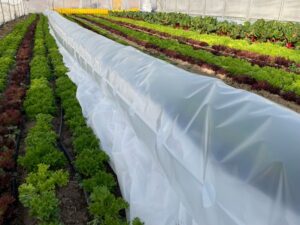
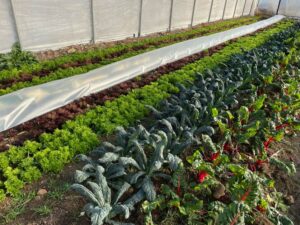
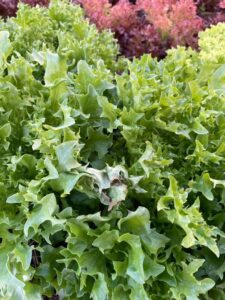
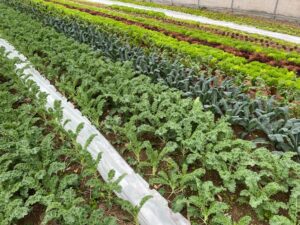

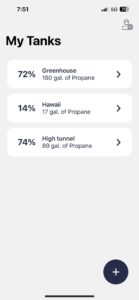
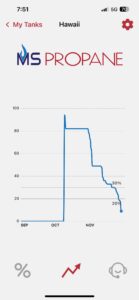
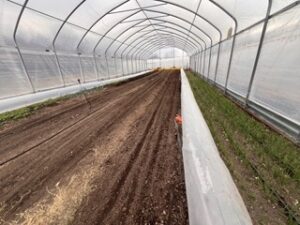
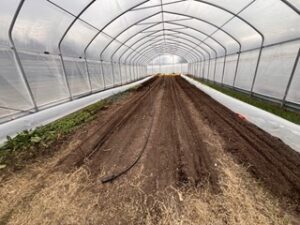
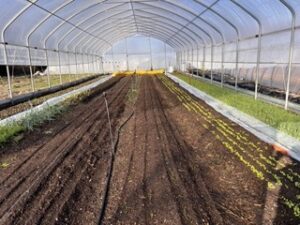
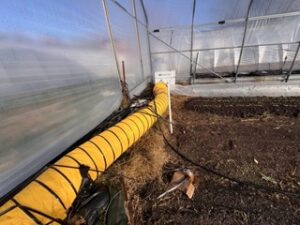
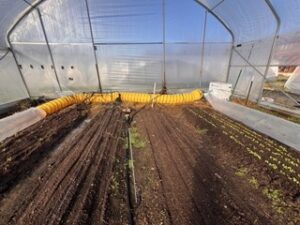
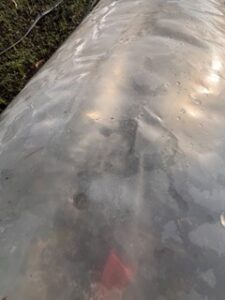
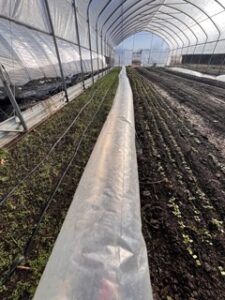
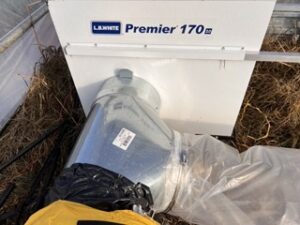
Educational & Outreach Activities
Participation Summary:
Millsap Farms has hosted over 30 farm tours this year, from full scale farmer field days to more casual tours of the farm with other growers during our weekly pizza nights. We regularly get questions about tunnel heating, and have found it to be a popular topic for tour goers. It appears that most other growers share similar concerns about the variability of the fall, winter and spring season, and are considering heating to address this. We don't know of any growers who have adopted our system out of hand, but there are many who have asked specific questions about the heaters and their interactions with the row covers.
Box Turtle Farm has created a youtube video to explain our project and our findings. The video has been slowly building views, but is over 250 at the time of this report. It has also triggered a couple of good discussions on Facebook grower groups like growing for market, and the market gardener group. The video is a great resource that will be available for perpetuity, and is a great milepost on the journey of figuring out best tools and practices for re-localizing the food supply.video Link https://www.youtube.com/watch?v=W05AwkLz4xo&t=129s
Learning Outcomes
After this project, both farms are much more confident that we can reliably produce a winter crop, which was our ultimate goal. The heaters allow us to be confident that 60 degree swings in temperatures won't destroy several month's worth of work. We have accomplished similar results with row covers in the past, but there is definitely a high price to pay for materials, labor, and worry when you start applying three layers of row cover to keep a crop alive, and the heaters allow us to grow some crops, like ranunculus, snap dragons, or romaine lettuce, that we have had very high loss rates with row cover alone.
Both farms are now using single layer row covers in their heated tunnels. The savings are well worth the increase hassle and labor of managing row cover. We are currently experimenting with lower temperatures on Millsap farms, and the jury is out on how well crops will do with thermostat set at 28 degrees.
We encourage everyone to try heating a little, but I'm not convinced it's a great strategy for beginners, who probably would be better served spending the resources on other details, like irrigation, row covers, alert systems, etc., before risking money on heaters and propane. That said, if a grower is getting good results from their winter growing, and would like to increase growth rates, decrease disease, and potentially harvest more, then experimenting with heaters is a good next step.
Project Outcomes
A large vegetable grower from near Columbia Missouri has adopted our practice of row-covers with a thermostatically controlled un-vented heater after seeing our systems and talking to us about our results.
We've interacted with several farmers on Facebook grower groups who are in the process of exploring heating systems for their tunnels, and helped point them away from mistakes we made, and encourage them with the successes we've experienced.